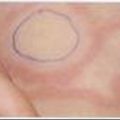8.3 Seizures and non-epileptic events
The child seen after the event
Differential diagnosis
Although there is overlap, it is helpful to approach the problem in terms of age of presentation. For neonatal seizures refer to Chapter 2.6.
Infancy
Breath-holding spells
 Pallid breath-holding attacks, where after a short cry, the infant loses consciousness, becomes pale and there may be tonic stiffening.
Pallid breath-holding attacks, where after a short cry, the infant loses consciousness, becomes pale and there may be tonic stiffening.Childhood
The child who is still fitting
The child with convulsive status epilepticus
At the same time, a history should be rapidly obtained regarding:
Investigations
These depend on the clinical setting but some general rules apply.
Chin R.F., Neville B.G., Scott R.C. Meningitis is a common cause of convulsive status epilepticus with fever. Arch Dis Childhood. 2005;90:66-69.
Maytal J., Shinnar S., Moshe S.L., Alvarez L.A. Low morbidity and mortality of status epilepticus in children. Paediatrics. 1989;83:323-331.
Mitchell W. Status epilepticus and acute repetitive seizures in children, adolescents and young adults: Etiology, outcome, and treatment. Epilepsia. 1996;37(Suppl 1):S74-S80.
Sofou K., Kristjansdottir R., Papachatzakis N.E., et al. Management of prolonged seizures and status epilepticus in childhood: a systemic at review. J Child Neurol. 2009;24:918-926.
The Status Epilepticus Working Party. The treatment of convulsive status epilepticus in children. Arch Dis Child. 2000;83:415-419.
Verity C.M., Ross E.M., Golding J. Outcome of childhood status epilepticus and lengthy febrile convulsions: Findings of national cohort study. Br Med J. 1993;307:225-228.









